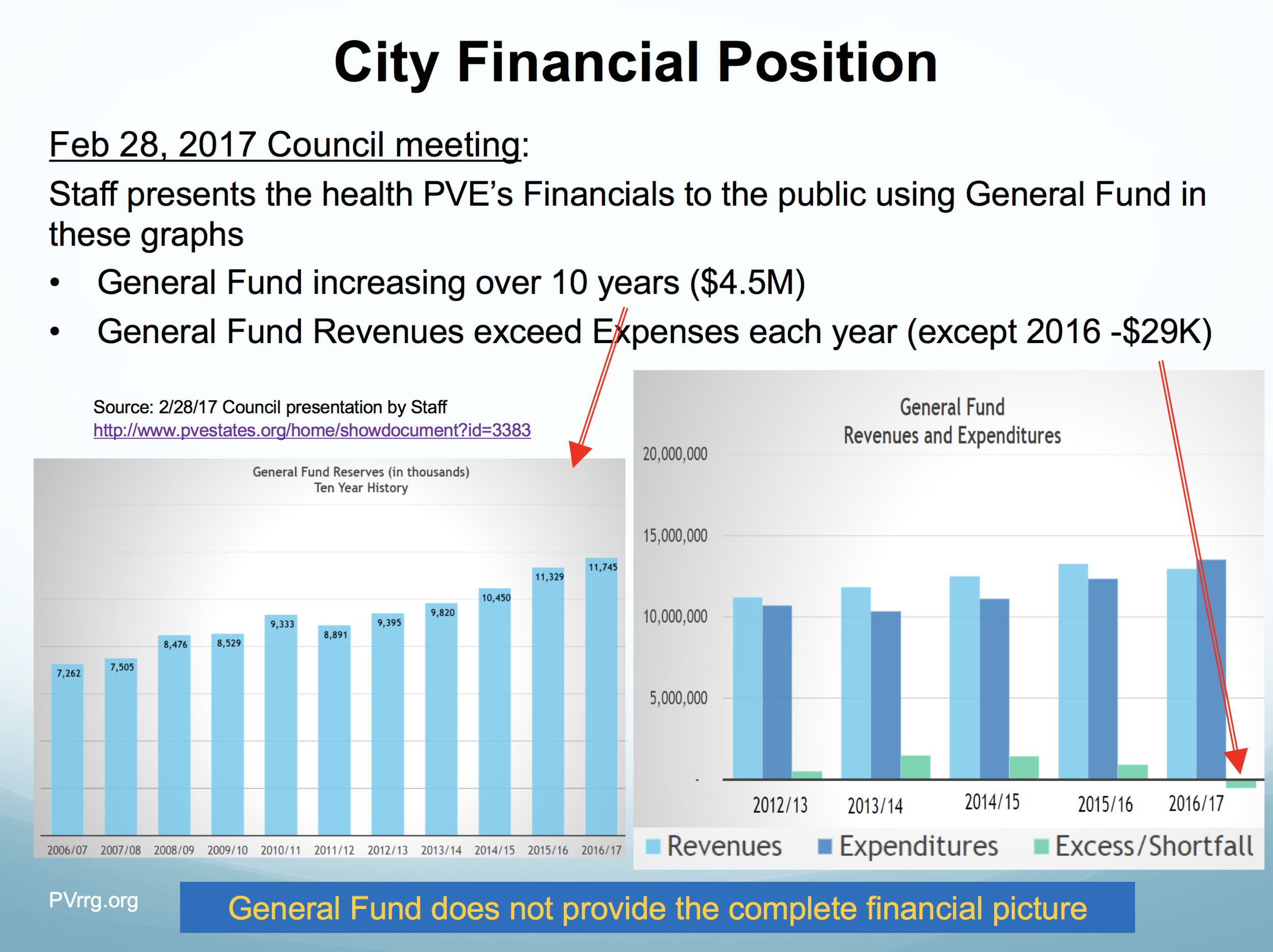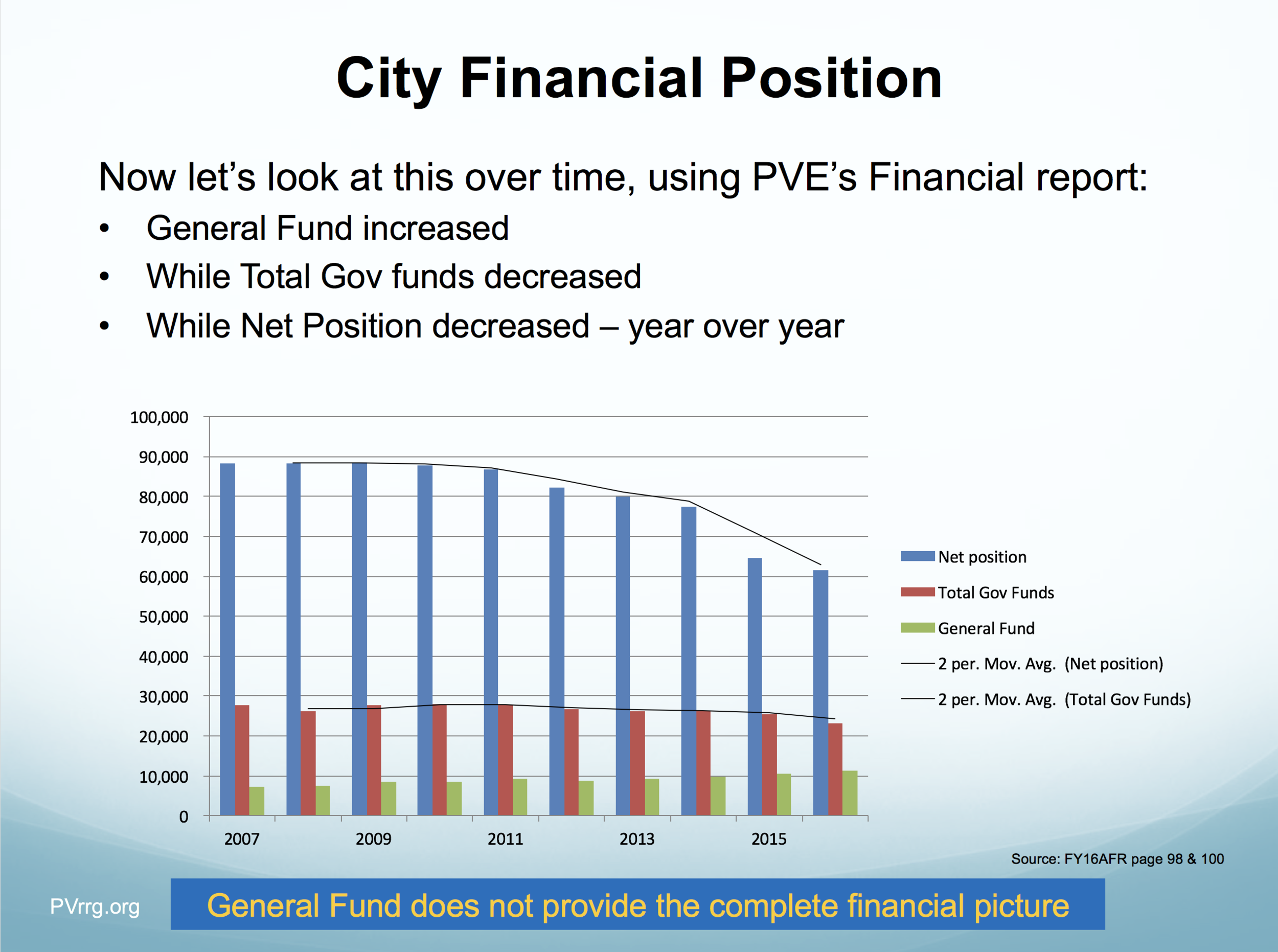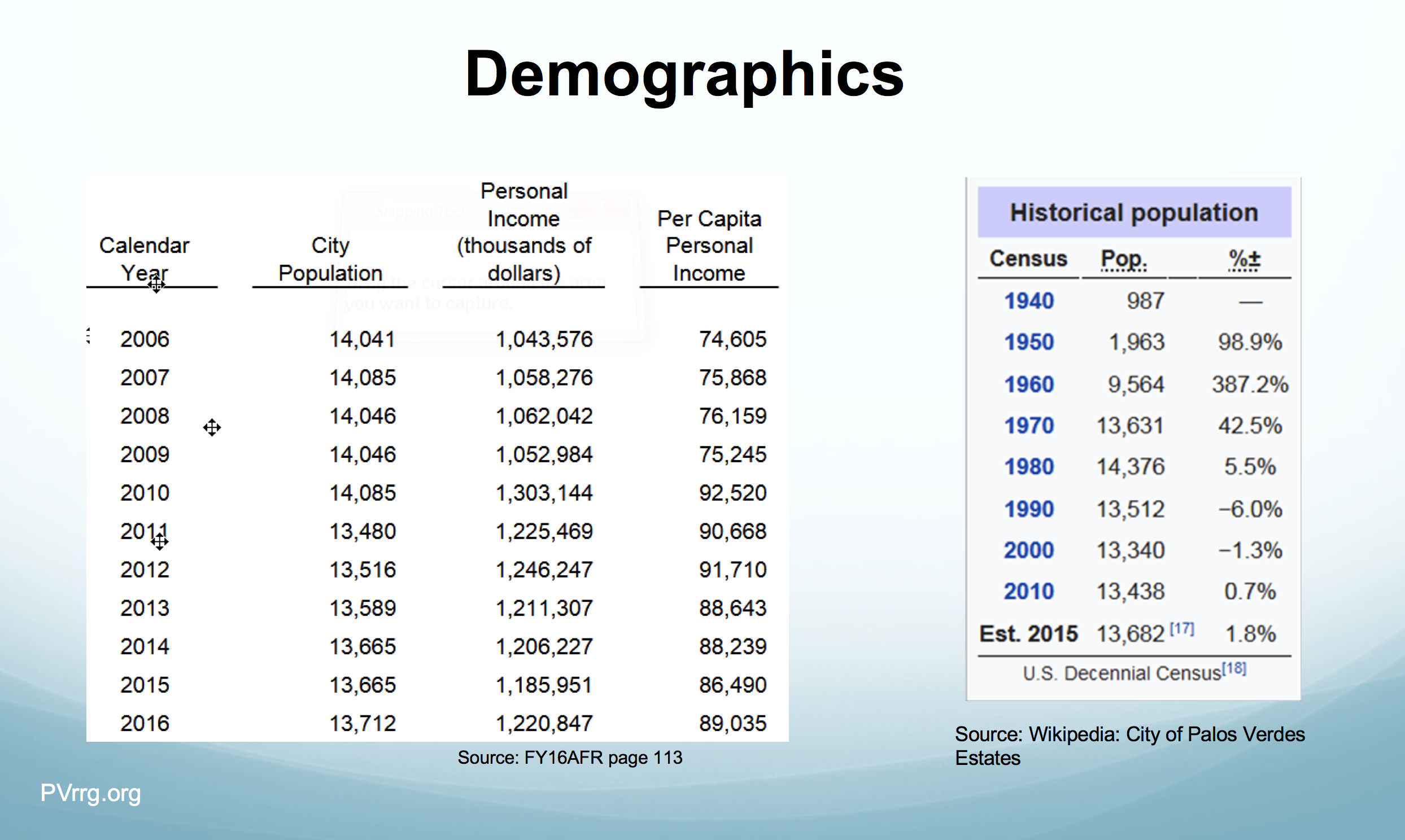“As government expands, liberty contracts”
On September 5, 2019, PVrrg Sent This Letter to our PVE City Council Members About the need for a Comprehensive Review of our Police Department Cost and options — click here.
Sign our Petition for a Balanced Budget
For more information including graphs and a downloadable petition, click here.
Description:
Our purpose in this analysis is to:
Understand information in financial reports that have raised significant concerns
Highlight recurring trends
Engage City in a dialogue to effectively exchange ideas and information and reach conclusions
Provide suggestions
Note the analysis on this page is based information in the Comprehensive Annual Financial Reports for the City of Palos Verdes Estates, and has shared with all five of our current PVE City Council members and our Treasurer. For the full presentation, click here. For the specific source documents used in this analysis, click the following links:
2016 AFR: History of Financials. PVE’s FY2016 Annual Financial Report
16/18 Budget: Future Financial plans. FY16-18 Adopted Budget
2017 Dollars and Cents: Feb 2017 Essay by City Mgr of the cost of maintaining city services
Since 2010, PVE's Net Position has declined by $14.5 million (see page 99 of 2016 AFR). Here is what the 2016 AFR says about this metric: "The statement of net position presents information on all of the City of Palos Verdes Estates’ assets and liabilities, with the difference between the two reported as net position. Over time, increases or decreases in net position may serve as a useful indicator of whether the financial position of the City of Palos Verdes Estates is improving or deteriorating.” (2016 AFR page 6)
What is driving these trends, and is this sustainable?
In March 2017, Council discussed a liability incurred by PVE when CalPERS changed discount rat. Council also commented that further reductions in discount rate are expected.
“By FY 2018/19, CalPERS cost increases are likely to double” (Source: City Mgr’s Dollars and Cents, pg 3)
This growth is concerning because PVE population has been flat for last 10 years, and PVE income has been flat (after adjustment for CPI increases). Many residents on fixed incomes.
Since 2013 when a new City Manager (Tony Dahlerbruch) was hired, the growth in spending is alarming for a city whose population is flat. Here are the cumulative changes in those three years comparing FY2016 to FY2013:
Overall revenues from all sources have grown 16.8%, but General Government expense has risen 44.2% from $1.50 M to $2.16M This has been due to 1) higher headcount (32 vs 28 in the listings on the PVE website) and 2) higher salaries which have jumped dramatically for some positions. Also pension costs have increased as work has shifted from contractors to employees, although it is not clear if those are captured in the General Government expense category
In the same period, Police has increased 21.1%
Fire has increased 9.8%
Parks and Recreation has increased 13.2%
Public Works has increased 71% from $1.26 M to $2.15 M.
This compares to cumulative inflation 2016 v 2013 of 3.0%
If expenses had been held to inflation over that period, $2.1 M in relief from the Parcel (Fire) Tax would have been captured. This is 47% of the current expenditures on Fire $4.5 M. So we’d be halfway there. For more analysis of the Parcel Tax, click here.
But we are a small city of only 13,000 or so people and our population is not growing. So we should be managing our spending to be flat in real terms. Here are the specifics:
A summary of where PVE got its revenue from in FY2016:
... and where PVE spent in FY2016:
In terms of trends, here is the trend in revenues:
...and the trend in spending:
Chronology of Events:
New City Manager hired in August 2013 (beginning of FY2014)
On April 25th, 2017 at 7:30 pm, the Palos Verdes Estates City Council will discussing its financial options in the aftermath of Measure D not passing. This regular City Council meeting will be held in City Council Chambers and the public is invited to participate. For the agenda and supporting documents, click here.
Voting Record of Elected Officials:
The current City Council unanimously voted to approve the FY2016 Budget
Voting For: Jim Goodhart, Jennifer King (Mayor), Betty Lin Peterson, John Rea, Jim Vandever (Mayor Pro-tem)
Voting Against: None
PVRRG Perspective:
PVrrg makes the following suggestions:
Increase community engagement
Utilize Community expertise
Provide transparency of financial docs to all residents
Plan ahead and avoid surprises: Create 5-10 year projections
Investigate what can be done to reduce costs in overall city functions
Improve key performance indicators – to measure productivity and accountability
Improve Council oversight of major decisions
Here are some near-term recommendations:
Recommendation 1 - Establish a Community-Based Financial Advisory Committee that reports to elected officials such as the City Council or City Treasurer
Our research into local government best practices has led us to very interesting ideas from organizations such as the Institute for Local Government (ILGA), (see the following link to their informative website about the importance of Public Engagement in various aspects of government including budgeting and decision making around public spending). For more info, click here.
One article included on the website is entitled “Public Engagement in Budgeting” which makes the argument for involving the public in this process for better public acceptance, and describes various approaches that can be utilized.
Of these approaches we favor the creation of a Community Based Financial Advisory Committee to utilize the high level of knowledge and expertise that exists among Palos Verdes Estates residents. Involving knowledgeable members of the public in this way also provides an enhanced opportunity for Council oversight of city spending. This Committee would work together with the City Treasurer and key members of the City staff to explore opportunities and make recommendations on opportunities to improve the City’s financial health.
As stated in ILG’s write-up on Budget Advisory Committees, “Advisory committees are a relatively easy and inexpensive way to include additional voices and fresh perspectives in the budgeting process. They also can provide greater transparency to the budgeting process by serving as a conduit of information to the larger community.”
Recommendation 2 - Establish a mechanism for an independent review of staffing levels, compensation policies and organizational efficiencies, with Council oversight
Recognizing that there are significant financial challenges ahead, we believe it’s incumbent upon the Council to ensure that every opportunity for cost savings and efficiency has been explored. While it’s often helpful in these sorts of situations to engage objective, outside experts and consultants in this type of effort, we believe that this is potentially another opportunity for public engagement where the appropriate expertise exists in the community. For example, many residents have worked in corporations that have had to address the need for cost-cutting and right-sizing when business conditions have changed. This experience could be applied to reviewing many of the city’s functions and departments.
On the other hand, there are some functional areas that are so unique to government, such as public safety, that employment of an outside expert would be helpful in assessing whether resources are allocated most efficiently. For example, is the ratio of uniformed police officers to office staff consistent with benchmarks that exist for other similarly sized communities? Are there efficiencies that could be achieved that would not affect either public safety or public confidence in our police department?
Consider establishing this mechanism as part of the Financial Advisory Committee or as a separate advisory body.
Recommendation 3 - Review processes around goal-setting and establishment of key performance indicators (metrics), and provide oversight of these processes to ensure maximum alignment, productivity and accountability
This type of process is often called Performance Measurement, and our recommendation is actually a critical precursor to optimizing both of the first two specific recommendations. ILG’s “Public Engagement in Budgeting” publication regarding goal setting states, “The Government Finance Officers Association (GFOA) . . . recommends . . . [that] goals can define what a community wants to preserve or what it wants to move toward. . . [that] goals also help decision-makers and the community set priorities for allocating limited resources . . . [and that] such goal setting can occur as part of the budget process or a separate strategic planning process.”
Often linked to the goal setting process is the establishment of key performance indicators or metrics to measure both the “what and the “how”, i.e. “what” needs to be accomplished as well as the quality of the accomplishment (the “how”). In addition to measuring goal attainment, these metrics are also very important in first establishing and then assessing the on-going appropriateness of staffing levels.
Quoting again from an ILGA publication “performance measurement is a management tool for systematically collecting clearly defined data regarding the effectiveness and efficiency of service delivery. The initial questions for elected officials to ask are:
Whether and how the [city] uses performance measure to assess its activities,
If the organization uses performance measurement, how is the resulting data analyzed and used in management decision-making (including decisions on allocating resources), and’
How are those results communicated to elected officials and the community?”
As with Recommendation 2, this Performance Measurement review could be conducted by the Financial Advisory Committee or by a separate advisory body.
Recommendation 4 – Make and announce changes that demonstrate to the public a willingness to embrace engagement, and not just transparency.
The City provides an extensive amount of information on its website and publications that cover the broad range of topics covered in the meetings of the City Council, the Planning Commission, the Parklands Committee and the Traffic & Safety Committee. This transparency is appreciated by residents who are curious enough to find out more about the local issues of interest to them. However, the processes in which the City engages the public for input and comment leave much to be desired. In our opinion, the City can vastly improve its relationship with the public by making and announcing certain changes that increase engagement, not just transparency. A Community Based Financial Advisory Committee would be one such initiative, but here are a few suggestions for others:
Publish agendas for meetings before the deadline for public comment, not after that deadline. In most cases, the agendas are published on Friday night, but the deadline for written public comment to be included in the package of materials is the day before (Thursday). Since no one has access to a time machine, this sends a clear signals that the City is really not interested in public comment. So please either publish the agenda earlier or allow written comments for several days after the agenda is published. A variation on this would be to post on the City Website a list of signs notifying matters of interest as the signs are posted – normally a couple of weeks before the topic appears on an agenda; a disclaimer could remind people to check for changes in agenda when they are sent out on Fridays because some changes are inevitable
Open City postings on Nextdoor to public comment, and make an effort to answer questions that are raised in those comments as well as correct misperceptions posted by the public
Provide a mechanism for residents to comment on statements made on the City’s “fact-check” page. Too often, the statements made by the City are misleading and this defeats the purpose of a page intended to clarify and enlighten.
Conduct facilitated workshop sessions for residents on important topics of interest to provide opportunities for information sharing, discussion and feedback that can be longer than the three minute resident speech limit in Council meetings.
Comments from the Public:
“The quality of your graphics is awesome. It is clear that something has happened in the last three years as the trend is WAY up and it is pretty clear this is not sustainable.”
If you would like to post your comment on this page, please fill in the form below. By submitting, you are granting permission for PVRRG to post your comment with attribution.


















